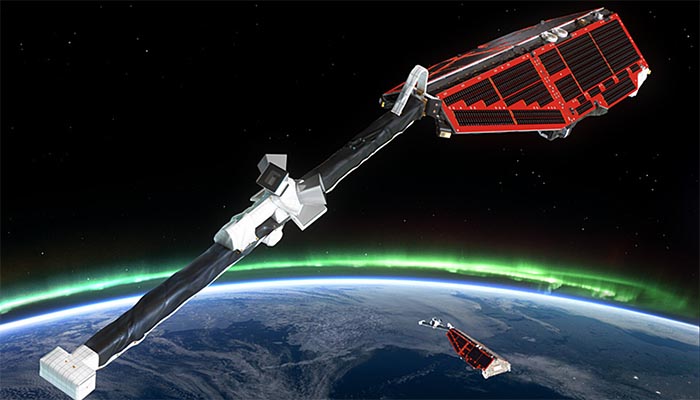Swarm in tune with atmospheric hot flushes
Scientists are harnessing data from ESA’s Swarm mission and ground-based instruments to precisely measure the strength and duration of intense upper-atmosphere heating – dramatic ‘hot flushes’ triggered by solar storms that also cause Earth’s tenuous outer atmospheric layers to expand rapidly.
This research, funded by ESA’s Earth Observation FutureEO Science for Society initiative, offers crucial insights into how geomagnetic activity affects satellite orbits and space weather conditions.
The Sun isn’t just a blazing ball of light, it’s a dynamic engine hurling massive bursts of energy and particles into space. High-speed streams of solar wind and coronal mass ejections – vast clouds of magnetised plasma launched by solar eruptions – can surge through space and slam into Earth’s magnetic field.
When this happens, geomagnetic storms are triggered, producing spectacular auroral light shows but also powerful electric currents in the upper atmosphere, from roughly at altitude of 110 km and above.
These currents cause what’s known as Joule heating – intense warming of the upper atmosphere that dramatically expands the thin gas layers surrounding our planet. This atmospheric expansion has consequences for satellites orbiting Earth.
Marcus Pedersen, from the University of Oulu in Finland, explained, “As the atmosphere swells, it increases drag on satellites in low-Earth orbit, particularly those orbiting below 600 km. This means that they experience more resistance, which could cause them to lose altitude unexpectedly.”
While scientists are well aware of this Joule heating phenomenon, the strength and duration of these hot flushes has not been well understood, until now.

At this week’s ESA Living Planet Symposium participants have been hearing how Marcus and team have been using data from ESA’s Swarm mission, the US–German GRACE mission and ground-based instrument networks to develop a cutting-edge method that tracked and quantified the scale of atmospheric density changes resulting from auroral Joule heating during 276 geomagnetic storms between 2010 and 2024.
During a typical storm, the northern hemisphere alone can experience up to 200 gigawatts of atmospheric heating – roughly the output of 150 nuclear power plants – sustained for several hours.
However, as the image above and the animation show, during superstorms, such as the dramatic solar activity in May 2024, heating levels soared to over 1100 gigawatts. The effects on atmospheric density at satellite altitudes are equally dramatic.
Heikki Vanhamäki, also from the University of Oulu, explained, “Using accelerometer and precise orbit determination data from the Swarm mission along with gravity data from the GRACE mission we measured up to 50% increases in air density at 450 km during regular storms.
“However, during superstorms we saw density spikes of up to 300% – a dangerous surge for satellites relying on stable orbits to function correctly.
“Such density increases can cause satellites to drift out of position, require more fuel for corrections, and in extreme cases, lead to premature de-orbiting.”
These findings will feed into new space weather forecasting systems, aimed at protecting Europe’s vital satellite infrastructure — from GPS and communications to Earth observation satellites critical for monitoring our planet.
As solar activity intensifies approaching the peak of the current solar cycle, these revelations underscore the importance of understanding and predicting the Sun’s tempestuous behaviour – and preparing for its powerful impact on the technology that we all rely on.
This research is funded by ESA’s Science for Society initiative, part of ESA’s FutureEO programme.
Source : ESA









Be the first to comment on "Swarm in tune"